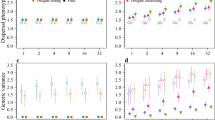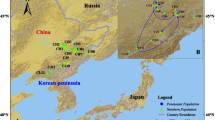Abstract
During range expansion, the most dispersive individuals make up the range front, and assortative mating between these dispersive phenotypes leads to increased dispersiveness (i.e. spatial sorting). The precise inheritance of dispersal, however, is to date largely unknown in many organisms, thereby hampering any progress in evaluating the adaptive potential of species during range expansion. Using the spider mite Tetranychus urticae, we therefore empirically simulated spatial sorting by means of artificial selection on a unique pre-dispersal behaviour, tightly related to emigration. To separate directionality of the response from potential drift, we mimicked a recurrent low number of founders in replicated selection regimes. Afterwards, we inferred the mode of inheritance of the pre-dispersal behaviour by performing reciprocal crosses between selected (i.e. dispersive) and non-selected (i.e. non-dispersive) mites and by screening for endosymbionts known to be associated with changes in dispersal behaviour. Despite the recurrent low number of founders, the aerial dispersal behaviour responded strongly to the imposed selection pressure. The behaviour furthermore showed a maternal inheritance, though independent of any known dispersal-related endosymbionts. Though cytoplasmic inheritance cannot fully be excluded, we attribute the observed strong and rapid, maternally influenced response in dispersal to transgenerational epigenetic effects. Consequently, we can expect fast evolutionary dynamics during range expansion in the species.



Similar content being viewed by others
References
Bitume EV, Bonte D, Magalhães S, San Martin G, Van Dongen S et al (2011) Heritability and artificial selection on ambulatory dispersal distance in Tetranychus urticae: effects of density and maternal effects. PLoS One 6(10):e26927. doi:10.1371/journal.pone.002692
Bitume EV, Bonte D, Ronce O et al (2013) Density and genetic relatedness increase dispersal distance in a subsocial organism. Ecol Lett 16(4):430–437
Bitume EV, Bonte D, Ronce O, Olivieri I, Nieberding CM (2014) Dispersal distance is influenced by parental and grand-parental density. Proc Biol Sci 281:20141061. doi:10.1098/rspb.2014.1061
Bonduriansky R, Crean AJ, Day T (2012) The implications of nongenetic inheritance for evolution in changing environments. Evol Appl 5(2):192–201
Bonte D, Van Belle S, Maelfait JP (2007) Maternal care and reproductive state-dependent mobility determine natal dispersal in a wolf spider. Anim Behav 74:63–69
Bossdorf O, Richards CL, Pigliucci M (2008) Epigenetics for ecologists. Ecol Lett 11(2):106–115
Carbonnelle S, Hance T, Migeon A et al (2007) Microsatellite markers reveal spatial genetic structure of Tetranychus urticae (Acari : Tetranychidae) populations along a latitudinal gradient in Europe. Exp Appl Acarol 41(4):225–241
Diss AL, Kunkel JG, Montgomery ME et al (1996) Effects of maternal nutrition and egg provisioning on parameters of larval hatch, survival and dispersal in the gypsy moth, Lymantria dispar L. Oecologia 106(4):470–477
Donohue K (1999) Seed dispersal as a maternally influenced character: mechanistic basis of maternal effects and selection on maternal characters in an annual plant. Am Nat 154(6):674–689
Fukatsu T, Nikoh N (2000) Endosymbiotic microbiota of the bamboo pseudococcid Antonina crawii (Insecta, Homoptera). Appl Environ Microbiol 66(2):643–650
Gaggiotti OE, Couvet D (2004) Genetic structure in Heterogeneous environments. In: Ferriere R, Dieckmann U, Couvet D (eds) Evolutionary conservation biology. Cambridge University Press, Cambridge, pp 229–243
Goodacre SL, Martin OY, Bonte D et al (2009) Microbial modification of host long-distance dispersal capacity. BMC Biol 7:32
Gotoh T, Noda H, Ito S (2007) Cardinium symbionts cause cytoplasmic incompatibility in spider mites. Heredity 98(1):13–20
Hanski I (ed) (1999) Metapopulation ecology. Oxford University Press, Oxford
Hanski I, Gaggiotti OE (eds) (2004) Ecology, genetics and evolution of metapopulations. Elsevier Academic Press, San Diego
Hill JK, Griffiths HM, Thomas CD (2011) Climate change and evolutionary adaptations at species’ range margins. Annu Rev Entomol 56:143–159
Holt RD (1985) Population dynamics in two-patch environments: some anomalous consequences of an optimal habitat distribution. Theor Popul Biol 28(2):181–208
Hoy MA, Jeyaprakash A (2005) Microbial diversity in the predatory mite Metaseiulus occidentalis (Acari : Phytoseiidae) and its prey, Tetranychus urticae (Acari : Tetranychidae). Biol Control 32(3):427–441
Jenuth JP, Peterson AC, Fu K et al (1996) Random genetic drift in the female germline explains the rapid segregation of mammalian mitochondrial DNA. Nat Genet 14(2):146–151
Jeyaprakash A, Hoy MA (2000) Long PCR improves Wolbachia DNA amplification: wsp sequences found in 76% of sixty-three arthropod species. Insect Mol Biol 9(4):393–405
Klopfstein S, Currat M, Excoffier L (2006) The fate of mutations surfing on the wave of a range expansion. Mol Biol Evol 23(3):482–490
Kot M, Lewis MA, van den Driessche P (1996) Dispersal data and the spread of invading organisms. Ecology 77(7):2027–2042
Krebs CJ, Keller BL, Tamarin RH (1969) Microtus population biology—demographic changes in fluctuating populations of M. ochrogaster and M. pennsylvanicus in Southern Indiana. Ecology 50(4):587–607
Lacey EP (1998) What is an adaptive environmentally induced parental effect? In: Mousseau TA, Fox CW (eds) Maternal effects as adaptations. Oxford University Press, New York, pp 54–66
Ledon-Rettig CC, Richards CL, Martin LB (2013) Epigenetics for behavioral ecologists. Behav Ecol 24(2):311–324
Levins R (1969) Some demographic and genetic consequences of environmental heterogeneity for biological control. Bull Entomol Soc Am 15:237–240
Li JB, Margolies DC (1993) Quantitative genetics of aerial dispersal behavior and life-history traits in Tetranychus urticae. Heredity 70:544–552
Li JB, Margolies DC (1994) Responses to direct and indirect selection on aerial dispersal behavior in Tetranychus urticae. Heredity 72:10–22
Massot M, Clobert J, Lorenzon P et al (2002) Condition-dependent dispersal and ontogeny of the dispersal behaviour: an experimental approach. J Anim Ecol 71(2):253–261
Mayr E (1963) Animal species and evolution. Harvard University Press, Cambridge
Mestre L, Bonte D (2012) Food stress during juvenile and maternal development shapes natal and breeding dispersal in a spider. Behav Ecol 23(4):759–764
Meylan S, Belliure J, Clobert J et al (2002) Stress and body condition as prenatal and postnatal determinants of dispersal in the common lizard (Lacerta vivipara). Horm Behav 42(3):319–326
Moran EV, Alexander JM (2014) Evolutionary responses to global change: lessons from invasive species. Ecol Lett 17(5):637–649
Noda H, Koizumi Y, Zhang Q et al (2001) Infection density of Wolbachia and incompatibility level in two planthopper species, Laodelphax striatellus and Sogatella furcifera. Insect Biochem Mol Biol 31(6–7):727–737
Perkins AT, Phillips BL, Baskett ML et al (2013) Evolution of dispersal and life history interact to drive accelerating spread of an invasive species. Ecol Lett 16(8):1079–1087
Perrot-Minnot MJ, Werren JH (1999) Wolbachia infection and incompatibility dynamics in experimental selection lines. J Evol Biol 12(2):272–282
Phillips BL, Brown GP, Shine R (2010) Life-history evolution in range-shifting populations. Ecology 91(6):1617–1627
Pierce AA, Zalucki MP, Bangura M, Udawatta M, Kronforst MR, Altizer S, Haeger JF, de Roode JC (2014) Serial founder effects and genetic differentiation during worldwide range expansion of monarch butterflies. Proc Biol Sci 281:20142230. doi:10.1098/rspb.2014.2230
Roach DA, Wulff RD (1987) Maternal effects in plants. Annu Rev Ecol Syst 18:209–235
Shine R, Brown GP, Phillips BL (2011) An evolutionary process that assembles phenotypes through space rather than through time. Proc Natl Acad Sci USA 108(14):5708–5711
Sinervo B, Calsbeek R, Comendant T et al (2006) Genetic and maternal determinants of effective dispersal: the effect of sire genotype and size at birth in side-blotched lizards. Am Nat 168(1):88–99
Smitley DR, Kennedy GG (1985) Photo-oriented aerial dispersal behavior of Tetranychus urticae (Acari, Tetranychidae) enhances escape from the leaf surface. Ann Entomol Soc Am 78(5):609–614
Tien NSH, Sabelis MW, Egas M (2011) Ambulatory dispersal in Tetranychus urticae: an artificial selection experiment on propensity to disperse yields no response. Exp Appl Acarol 53(4):349–360
Tschirren B, Fitze PS, Richner H (2007) Maternal modulation of natal dispersal in a passerine bird: an adaptive strategy to cope with parasitism? Am Nat 169(1):87–93
Tuomainen U, Candolin U (2011) Behavioural responses to human-induced environmental change. Biol Rev 86(3):640–657
Van Leeuwen T, Tirry L, Nauen R (2006) Complete maternal inheritance of bifenazate resistance in Tetranychus urticae Koch (Acari : Tetranychidae) and its implications in mode of action considerations. Insect Biochem Mol Biol 36(11):869–877
Van Leeuwen T, Vanholme B, Van Pottelberge S et al (2008) Mitochondrial heteroplasmy and the evolution of insecticide resistance: non-Mendelian inheritance in action. Proc Natl Acad Sci USA 105(16):5980–5985
Verbeke G, Molenberghs G (eds) (2000) Linear mixed models for longitudinal data. Springer, New York
Via S, Lande R (1985) Genotype–environment interaction and the evolution of phenotypic plasticity. Evolution 39(3):505–522
Weeks AR, Velten R, Stouthamer R (2003) Incidence of a new sex-ratio-distorting endosymbiotic bacterium among arthropods. Proc R Soc B Biol Sci 270(1526):1857–1865
Weisburg WG, Barns SM, Pelletier DA et al (1991) 16S ribosomal DNA amplification for phylogenetic study. J Bacteriol 173(2):697–703
Yano S, Takafuji A (2002) Variation in the life history pattern of Tetranychus urticae (Acari : Tetranychidae) after selection for dispersal. Exp Appl Acarol 27(1–2):1–10
Acknowledgments
This project was funded by the Fund for Scientific Research - Flanders (FWO) (project G.0610.11). We also thank the Fund for Scientific Research - Flanders (FWO) for funding JP (visiting postdoctoral fellowship: FWO-project G. G0057/09 N). DB and RS were supported by BelSpo IAP Project “Speedy”. We furthermore thank the INEE-CNRS (ENVIROMICS call, project ‘ALIENS’) for funding DR. Finally, we thank Pim Edelaar, Cristina García and John Endler for inviting us and we thank two anonymous reviewers and Pim Edelaar for their useful comments on earlier versions of this manuscript.
Author information
Authors and Affiliations
Corresponding author
Rights and permissions
About this article
Cite this article
Van Petegem, K.H.P., Pétillon, J., Renault, D. et al. Empirically simulated spatial sorting points at fast epigenetic changes in dispersal behaviour. Evol Ecol 29, 299–310 (2015). https://doi.org/10.1007/s10682-015-9756-9
Received:
Accepted:
Published:
Issue Date:
DOI: https://doi.org/10.1007/s10682-015-9756-9




